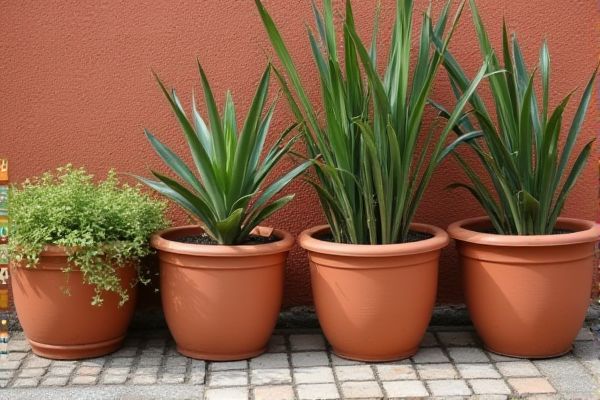
Terracotta terrace planters offer natural breathability and excellent moisture regulation, making them ideal for healthy plant growth, while glazed pottery planters provide a waterproof barrier that enhances durability and prevents soil dryness. Explore the rest of the article to discover which option best suits your gardening needs and aesthetic preferences.
Table of Comparison
| Feature | Terracotta Planters | Glazed Pottery Planters |
|---|---|---|
| Material | Porous natural clay | Clay coated with a glassy glaze |
| Water Retention | Allows better air and water flow; dries out faster | Retains moisture longer due to non-porous surface |
| Weight | Generally lighter | Heavier due to glaze layer |
| Durability | Prone to cracking in freezing conditions | More resistant to weather and chipping |
| Appearance | Natural, rustic look with earthy color | Shiny, colorful, and smooth finish |
| Cost | Typically lower cost | Generally higher cost due to finishing |
| Ideal Use | Plants needing good drainage; Mediterranean style | Decorative plants; wetter environments |
Introduction to Terracotta and Glazed Pottery
Terracotta terrace planters are crafted from porous clay that allows for excellent air and water permeability, promoting healthy root growth and moisture regulation for plants. Glazed pottery terrace planters feature a non-porous, glass-like surface achieved through a ceramic glaze, providing enhanced water retention and resistance to weathering. Choosing between terracotta and glazed pottery depends on the specific needs of your plants and aesthetic preferences for your outdoor space.
Material Composition and Manufacturing Process
Terracotta terrace planters are made from natural clay that is shaped and fired at relatively low temperatures, resulting in a porous and breathable material that helps regulate moisture for plant roots. Glazed pottery planters, however, undergo an additional step where a glass-like coating is applied before a higher temperature firing, creating a non-porous, water-resistant surface that prevents water evaporation but may trap moisture inside. Your choice between terracotta and glazed planters should consider how these differences in material composition and manufacturing affect drainage, moisture retention, and plant health.
Visual Appeal: Texture and Color Differences
Terracotta terrace planters feature a natural, porous texture with warm, earthy red and orange hues that develop a rustic, weathered patina over time. Glazed pottery terrace planters offer a smooth, glossy surface with vivid, varied colors that resist fading and enhance decorative appeal. The contrast between terracotta's matte, organic finish and glazed pottery's shiny, vibrant look provides distinct aesthetic options for outdoor spaces.
Durability and Weather Resistance
Terracotta terrace planters, made from porous clay, offer natural breathability but tend to be less durable in extreme weather conditions, often cracking in freezing temperatures. Glazed pottery planters feature a protective, non-porous surface that enhances weather resistance, preventing water absorption and increasing longevity in harsh climates. While glazed planters require less maintenance and withstand moisture better, terracotta's porous nature supports plant root health by allowing air and moisture exchange.
Breathability and Plant Health
Terracotta pots offer superior breathability due to their porous nature, allowing air and moisture to pass through the walls, which helps prevent root rot and promotes healthier plant growth. Glazed pottery lacks this porosity, retaining moisture longer but increasing the risk of waterlogging and fungal issues. For terrace planters, terracotta is ideal for plants requiring well-drained soil and good aeration, while glazed pottery suits moisture-loving species that benefit from consistent soil hydration.
Water Retention Capabilities
Terracotta terrace planters exhibit excellent breathability, allowing water to evaporate through their porous surface, which helps prevent overwatering but requires more frequent irrigation. Glazed pottery terrace planters have a non-porous surface that retains water longer, reducing the need for frequent watering but increasing the risk of waterlogging if drainage is insufficient. Understanding these water retention capabilities is crucial for selecting the right planter based on the specific moisture needs of your plants.
Maintenance and Cleaning Requirements
Terracotta terrace planters require regular watering and occasional sealing to prevent moisture absorption and cracking, with cleaning involving gentle scrubbing and rinsing to remove dirt and mineral deposits. Glazed pottery planters are more water-resistant and easier to clean, as their smooth surface repels stains and reduces buildup, making maintenance less frequent and simpler. Your choice depends on how much time you want to spend on upkeep and whether you prefer a more natural or polished look for your outdoor space.
Cost Comparison: Terracotta vs Glazed Planters
Terracotta planters typically cost less than glazed pottery due to their simpler manufacturing process and natural clay material, making them a budget-friendly option for terrace gardening. Glazed planters, offering vibrant colors and a waterproof finish, usually come at a higher price point because of the additional glazing and firing steps involved. Choosing between terracotta and glazed terrace planters depends on balancing upfront expense against aesthetic preferences and durability requirements.
Best Applications for Terrace Planters
Terracotta terrace planters excel in breathability and natural water evaporation, making them ideal for Mediterranean plants and succulents needing well-drained soil conditions. Glazed pottery planters offer superior moisture retention and vibrant aesthetics, perfect for tropical or moisture-loving plants on shaded terraces. Choosing between terracotta and glazed planters depends on the specific plant's water requirements and the terrace's microclimate to ensure optimal growth and planter longevity.
Eco-Friendliness and Sustainability
Terracotta terrace planters offer superior eco-friendliness due to their natural, biodegradable composition made from clay, which minimizes environmental impact during production and disposal. Glazed pottery planters, coated with non-biodegradable materials, often involve energy-intensive firing processes and may release microplastics or chemicals as they degrade. Choosing unglazed terracotta supports sustainability by promoting natural water evaporation, enhancing plant health, and reducing synthetic waste in gardening practices.
 homyna.com
homyna.com